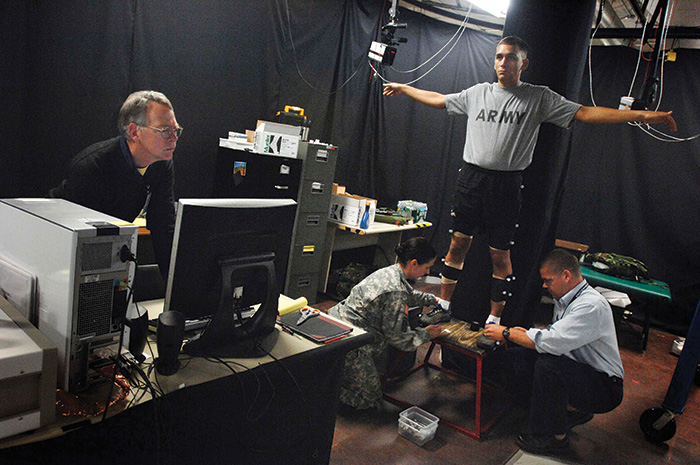Musculoskeletal Injuries: Modifiable and Non-modifiable Risks and Strategies for Prevention

Serving in the military as a Soldier, Sailor, Airmen or Marine is arduous. The physical demands placed upon the Warfighter are challenging and can be more debilitating than standard occupational injuries. Musculoskeletal injuries are the leading cause of healthcare utilization and disability in the Army and today 76 percent of the non-deployable force is due to musculoskeletal injuries.
These injuries can be attributed to a variety of modifiable and non-modifiable factors. Modifiable factors include habits and behaviors that can be changed or modified, such as body mass index, tobacco use and Army Physical Fitness Test scores. Non-modifiable factors are characteristics that cannot be changed such as age or gender.
The studies conducted by Military Health System researchers aims to prevent physical injuries through the development of injury prediction models, equipment design specifications and guidelines, health hazard assessment criteria and strategies to reduce injuries. Musculoskeletal injury research was one of many topics discussed during the 2016 Military Health System Research Symposium, Aug. 15-18 at the Gaylord Hotel and Convention Center in Kissimmee, Florida.
The Musculoskeletal Injury Prevention panel was co-moderated by the U.S. Army Medical Research and Materiel Command's Dr. Richard Shoge, Injury Prevention Portfolio Manager with the Military Operational Medicine Research Program and Maj. Richard Westrick, Deputy Chief of the Military Performance Division with the U.S. Army Medical Research Institute of Environment Medicine. The panelists included six researchers from across the services, who discussed current and future research efforts that are paving the way for musculoskeletal injury research across the services.
The panel began with two presentations from Lt. Col. Sheryl Bedno, Chief of Preventive Medicine at Womack Army Medical Center. The focus of her presentations covered the various factors that may lead to musculoskeletal injuries, particularly lower extremity injuries, among new U.S. Army Soldiers. New Soldiers were a particularly viable population for this study, as past research has shown a higher rate of injuries among this group.
The first study looked at profile data of 188,000 new U.S. Army Soldiers ranging in age from 20-24, to examine the gender differences in order to estimate the incidence of lower extremity conditions that resulted in limited duty days as well as the total days of limited duty attributed to such conditions for new Soldiers during their first two to three years of service. The study found that 39 percent of females and 28 percent of males had at least one profile. Furthermore, the probability of a lower extremity limited duty injury for females entering the military nearly doubled from 27 to 40 percent over the course of their first 24 months in the military. In terms of readiness, this translates to approximately 6.3 million person days limited due to lower extremity injuries.
The second study looked at the impact of body mass index and tobacco use on lower extremity injuries among new U.S. Soldiers. While modifiable, these factors present important health and readiness issues for the Army. In today's society, the Army is not immune to the obesity and tobacco-use problems that plague the U.S. These issues present challenges throughout the Army beginning in recruiting efforts. In an occupation where readiness is key to mission success; exceeding the recommended BMI is associated the musculoskeletal injuries, especially lower extremity injuries. Tobacco use is known to decrease bone density and increase the risk for bone fractures, pre-operative complications, infections as well as delay wound healing. This study compared BMI, tobacco-use and Army Physical Fitness Test scores and concluded that there is a greater likelihood of musculoskeletal injury among underweight, overweight and obese enlisted males. Additionally, tobacco use is consistently associated with a higher risk of injury.
While some research looks at the causes of injury, other research focuses on screening tools to predict or mitigate injuries.
The Uniformed Services University's Consortium for Health and Military Performance Injury Prevention Laboratory is leading the MEPStart program a four service, cohort study looking to identify modifiable factors (BMI, tobacco use, fitness level, etc.) in order to identify risks early to implement injury prevention strategies.
Another study funded by the USAMRMC, considers bone area against length and tissue density to determine the impact on stress fractures. This study looked at peripheral quantitative computed tomography, a type of quantitative computed tomography, used for making measurements of the bone mineral density in peripheral parts of the body, such as the arms or legs. The study scanned the tibias of its subjects and reviewed the data to locate subjects that may be susceptible to tibial stress injuries. The aim of the study is the better understand risk factors to allow for better screening and injury prevention.
This research highlights just one topic, in which the MHS and USAMRMC are considering all angles, to address, treat and mitigate risks in order to maintain readiness and the health of the Warfighter. Gatherings, such as the 2016 MHSRS provide a collaborative forum for researchers to share and discuss their efforts.














